Physical Address
304 North Cardinal St.
Dorchester Center, MA 02124
Physical Address
304 North Cardinal St.
Dorchester Center, MA 02124
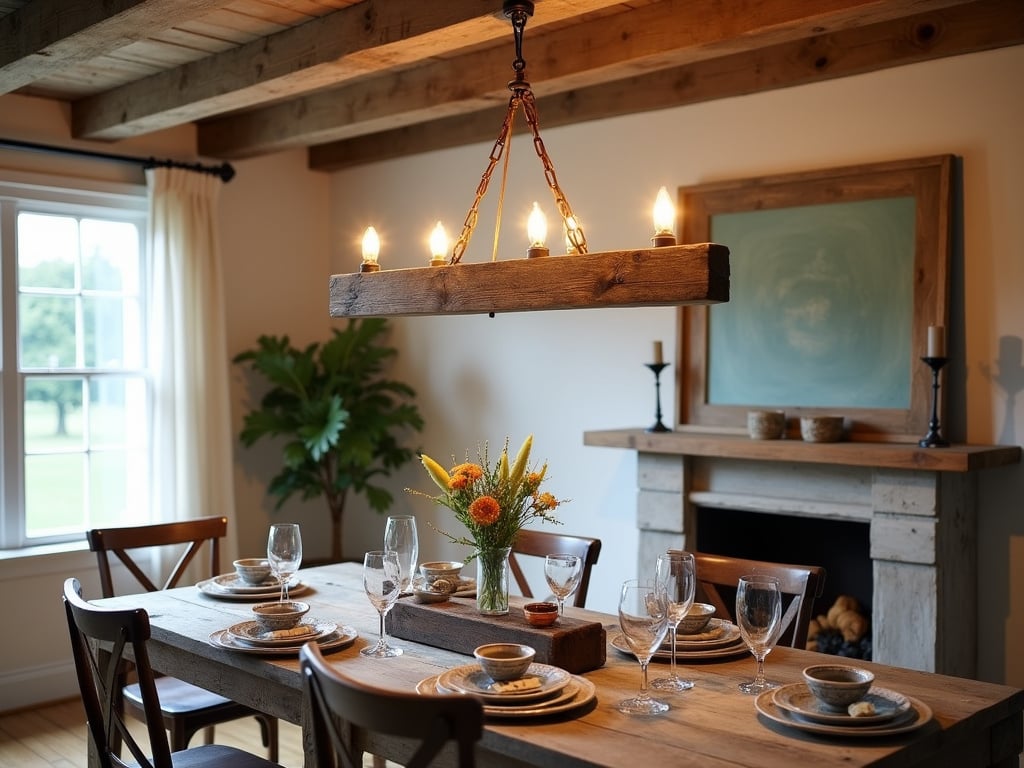
The psychology of space tells us that our environment directly impacts our behavior, emotions, and social interactions. Nowhere is this more evident than in the dining room, where lighting plays a crucial role in shaping our experiences. Research shows that the right dining room lights can transform a simple meal into a memorable gathering, influencing everything from conversation flow to appetite. Let’s explore how thoughtful lighting choices can revolutionize your dining space, backed by both scientific insight and design expertise.
The human brain is naturally drawn to hierarchical visual elements, and a statement chandelier serves as what environmental psychologists call a “dominant focal point.” This architectural anchor doesn’t just illuminate your space – it creates a powerful first impression that sets the tone for the entire dining experience. Research indicates that rooms with well-defined focal points tend to feel more organized and purposeful, leading to increased comfort levels among occupants.

When selecting a statement chandelier, consider both its physical and psychological proportions. The standard rule suggests adding your dining table’s length and width (in feet), then converting that sum to inches for your ideal chandelier diameter. However, equally important is the fixture’s visual weight – how it makes people feel in the space. A chandelier that’s technically the right size but too ornate can create cognitive overwhelm, while one that’s too simple might fail to establish the desired emotional impact.
As we shift our focus from grand statements to modern minimalism, we’ll explore how simple forms can create equally powerful psychological effects.
Studies in environmental psychology reveal that clean, uncluttered spaces reduce cognitive load and promote mental clarity – precisely what modern minimalist pendant lighting achieves. These streamlined fixtures embody the principle of “less is more,” creating what researchers call “visual rest points” that allow our minds to process and appreciate the dining experience without distraction.

When installing minimalist pendants, consider their rhythm and spacing. Our brains naturally seek patterns, and a well-planned arrangement of three pendants over a rectangular table creates what design psychologists term “visual harmony.” The recommended spacing of 24-30 inches between pendants isn’t arbitrary – it’s based on how our eyes naturally scan horizontal spaces and process visual information.
Before we explore the warmth of rustic lighting, consider how this mathematical precision in minimalist design creates a foundation for more expressive styles.
The appeal of rustic farmhouse lighting taps into what environmental psychologists call “biophilic design” – our innate connection to natural materials and forms. When we incorporate elements like weathered wood, wrought iron, and warm Edison bulbs into our dining room lights, we’re actually engaging with deep-seated psychological comfort triggers that remind us of simpler, more grounded times.

Research shows that spaces featuring natural materials and warm lighting increase oxytocin levels – often called the “bonding hormone” – making them ideal for family gatherings and social connections. A wagon wheel chandelier or mason jar pendant isn’t just a style choice; it’s a subtle way to encourage more relaxed, intimate conversations and stronger social bonds around the dining table.
As we transition to industrial chic lighting, notice how we maintain that connection to authentic materials while shifting to a more urban psychological framework.
The psychology behind industrial chic lighting is fascinating – it appeals to what researchers call “temporal contrast,” where the juxtaposition of historical industrial elements with modern dining spaces creates cognitive intrigue. Exposed bulbs, metal cages, and raw materials trigger what environmental psychologists term “architectural honesty,” making spaces feel more authentic and engaging.

When incorporating industrial dining room lights, consider their impact on social dynamics. Studies show that spaces with visible mechanical elements tend to stimulate more active, energetic conversations – perfect for dinner parties and creative gatherings. The key is balancing these raw elements with softer textures in your dining space to maintain psychological comfort.
Let’s explore how we can elevate this architectural honesty to pure luxury with crystal chandeliers, where light itself becomes the star of the show.
The human brain processes sparkle and light refraction in a unique way – crystal chandeliers tap into what neuroscientists call the “reward center,” creating an immediate sense of luxury and occasion. This isn’t just about aesthetics; research shows that multi-faceted lighting creates micro-changes in illumination that keep our minds engaged and alert, enhancing social interactions.

The psychological impact of a crystal chandelier extends beyond its immediate visual appeal. Studies indicate that spaces with dynamic light play – like that created by crystal prisms – tend to be remembered more vividly and associated with positive experiences. This makes crystal dining room lights particularly effective for spaces meant to host special occasions and memorable gatherings.
Speaking of memorable experiences, let’s explore how we can enhance them further through the power of adjustable lighting.
Research in environmental psychology consistently shows that the ability to control our environment significantly impacts our comfort and well-being. Dimmable dining room lights offer what experts call “environmental mastery” – the power to adjust our surroundings to match our psychological needs at any given moment.
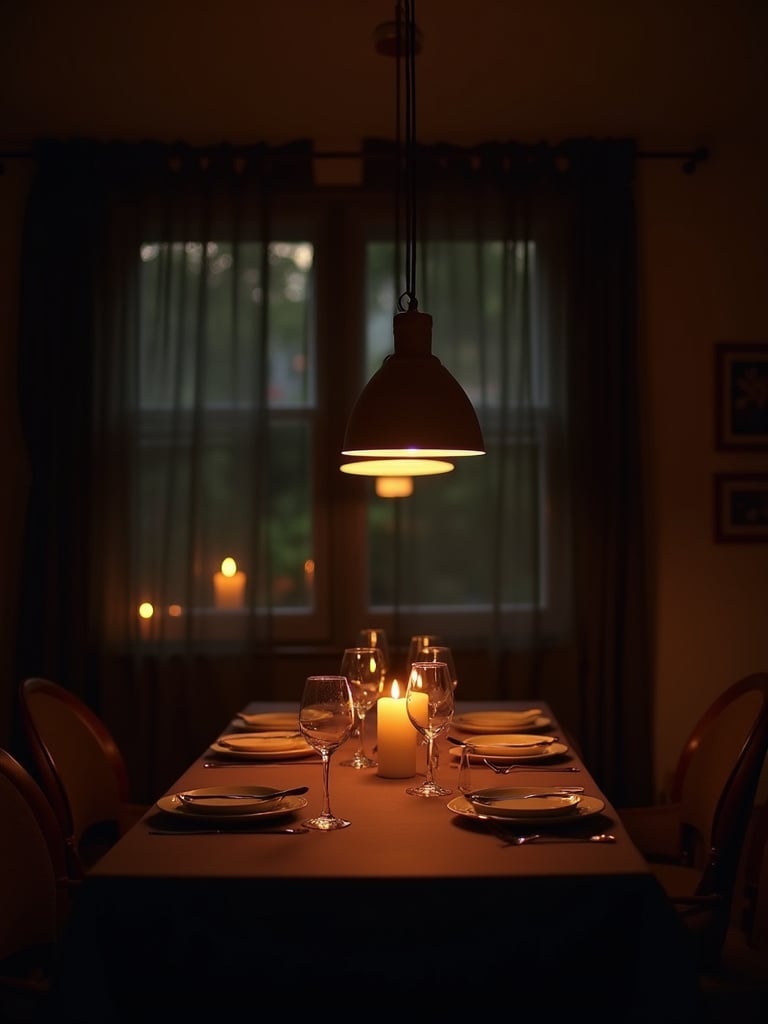
Studies reveal that different lighting levels trigger distinct psychological responses. Bright light (around 2700-3000 lumens) promotes alertness and active conversation, perfect for family brunches, while dimmer settings (around 1500 lumens) encourage relaxation and intimate discussions. This flexibility in lighting allows your dining space to adapt to various social scenarios and emotional needs.
Now, let’s explore another way to perfect your dining room’s lighting flexibility through adjustable pendant heights.
Environmental psychology teaches us that ceiling height and light fixture positioning significantly impact our perception of space and social behavior. Adjustable pendant lights provide what researchers call “spatial adaptability” – the ability to modify our environment to suit different social contexts and psychological needs.

The flexibility of adjustable dining room lights goes beyond mere functionality. Studies show that rooms with adaptable elements make people feel more in control of their environment, leading to increased comfort and social ease. Whether you’re hosting a casual family dinner or an elegant cocktail party, the ability to modify light height allows you to create the perfect psychological atmosphere for any occasion.
As we consider the importance of adaptability in lighting, let’s explore how modern LED technology can help us create perfect ambiance while being environmentally conscious.
Recent studies in environmental psychology have shown that sustainable design elements like LED lighting can actually enhance our emotional connection to a space. When we know our dining room lights are energy-efficient, it triggers what researchers call “environmental stewardship satisfaction” – a positive psychological response to making environmentally conscious choices.
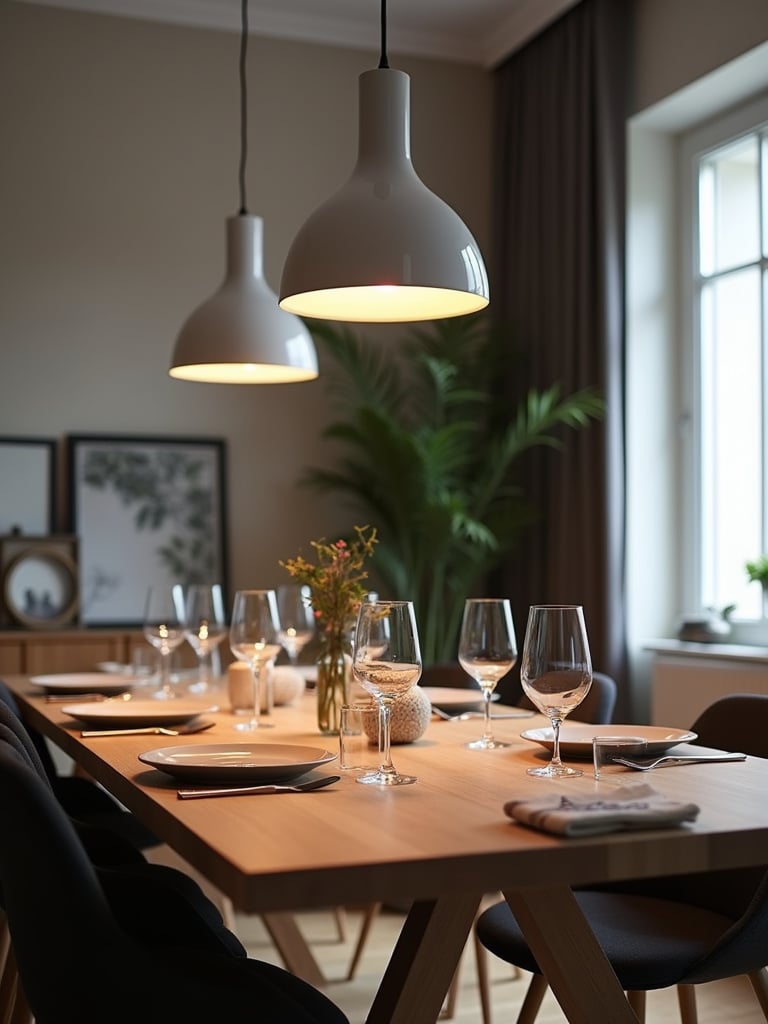
Modern LED technology has revolutionized how we think about dining room illumination. Beyond their energy efficiency, LED lights offer unprecedented control over color temperature, allowing us to fine-tune the psychological impact of our lighting. Research indicates that warmer LED tones (2700K-3000K) promote relaxation and social bonding, making them perfect for dining spaces.
The psychology of spatial perception tells us that linear elements can dramatically influence how we experience a room. Linear chandeliers capitalize on what researchers call “architectural alignment” – the pleasing psychological effect that occurs when lighting fixtures mirror the shape and proportion of the dining table below them. This alignment creates a sense of order and intention that our brains naturally appreciate.
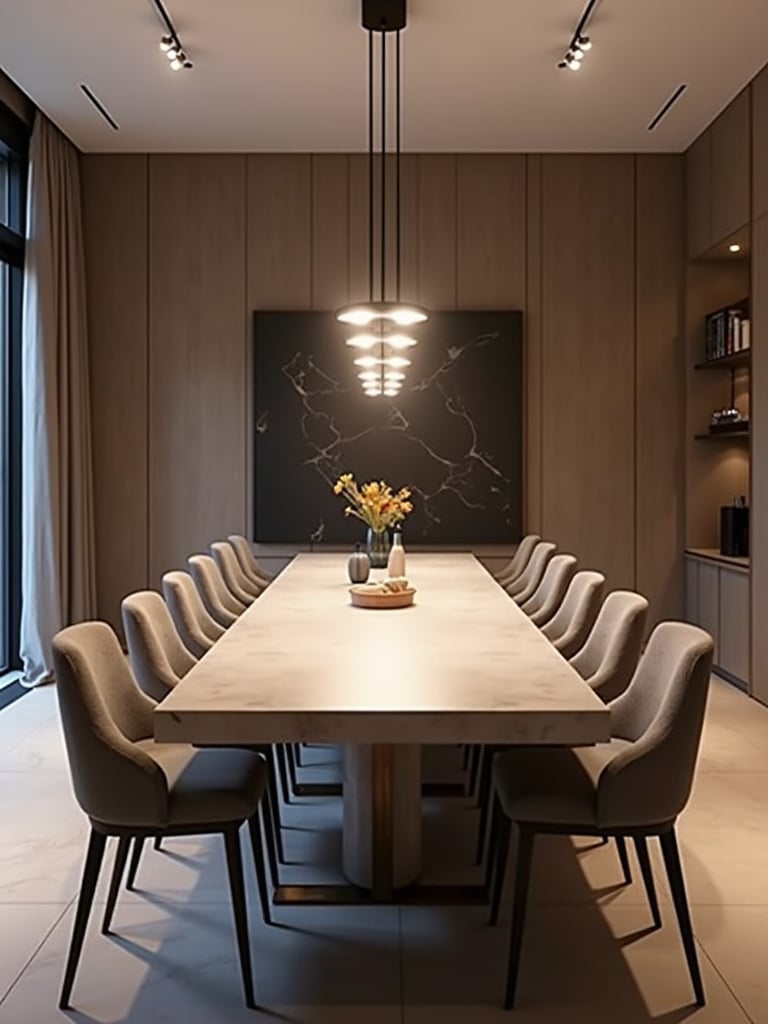
Research in environmental psychology has shown that balanced, proportional lighting distribution affects everything from conversation patterns to dining behavior. A linear chandelier spanning the length of a rectangular table ensures every diner experiences equal illumination, promoting what social psychologists call “democratic spacing” – an arrangement that subtly encourages equal participation in conversations and shared experiences.
As we consider solutions for different spatial challenges, let’s explore how thoughtful lighting choices can transform even the most challenging ceiling heights.
Environmental psychology research has consistently shown that ceiling height affects cognitive processing and social behavior. In spaces with lower ceilings, strategic lighting becomes crucial in what we call “spatial compensation” – using design elements to create the perception of greater height and openness. The right dining room lights can transform a potentially challenging space into an intimate, welcoming environment.
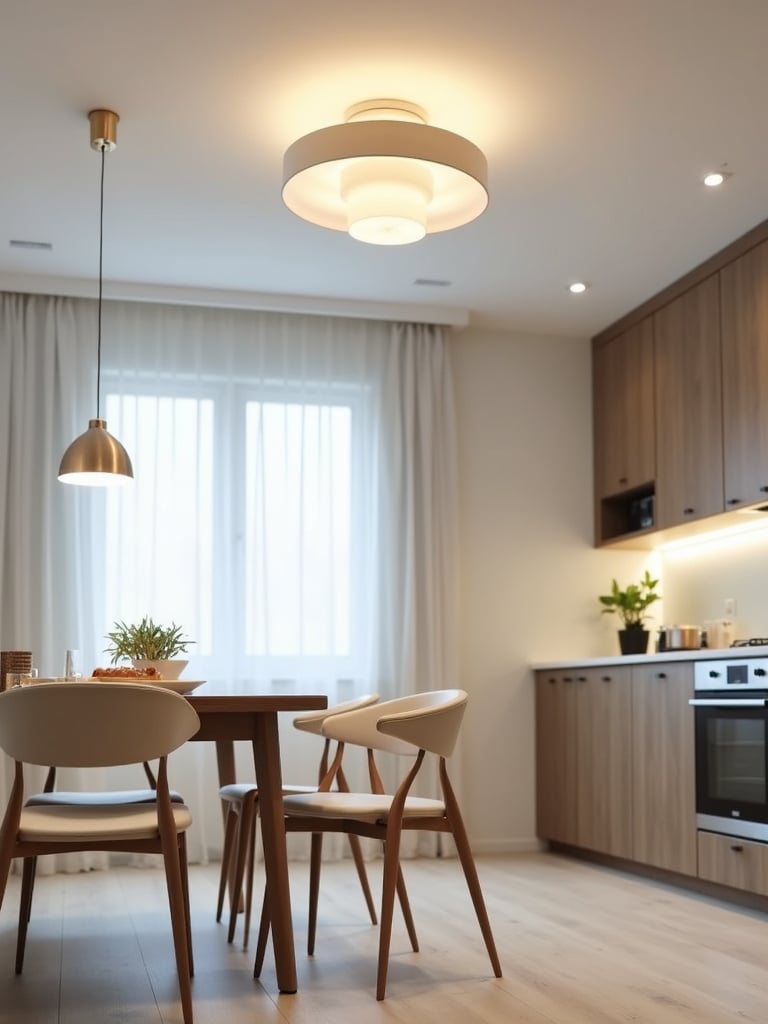
When working with low ceilings, our brain’s perception of space responds particularly well to layered lighting techniques. Studies show that combining close-to-ceiling fixtures with strategic wall lighting creates what designers call “vertical depth perception,” helping the room feel more expansive without physically changing its dimensions. This psychological trick makes low-ceiling dining rooms feel less constraining and more inviting.
Moving from spatial challenges to versatile solutions, let’s explore how semi-flush mounts offer an elegant compromise between form and function.
The psychology behind semi-flush mount dining room lights is fascinating – they create what researchers call “transitional space perception,” bridging the gap between ceiling-hugging fixtures and hanging pendants. This intermediate position triggers a subconscious sense of balance that many people find particularly pleasing.

Studies in environmental psychology suggest that fixtures at this middle height create an optimal “intimate zone” in dining spaces. Not so high as to feel disconnected, nor so low as to create visual barriers, semi-flush mounts help establish what experts call “psychological comfort scaling” – the perfect balance between openness and intimacy in a dining setting.
Let’s shift our focus from fixed mounting positions to lighting that offers ultimate flexibility in both position and direction.
Research in environmental psychology has revealed that directional lighting significantly impacts our attention patterns and spatial awareness. Track lighting in dining rooms creates what experts call “focused attention zones,” allowing us to highlight specific areas while maintaining overall ambient illumination. This flexibility in directing light can fundamentally alter how we perceive and interact with our dining spaces.

The psychological impact of adjustable lighting extends beyond mere functionality. Studies show that spaces with variable lighting directions create what researchers term “dynamic environmental engagement” – our brain stays more active and engaged when light can be redirected to create different moods and highlight different areas. This makes track lighting particularly effective for dining rooms that serve multiple purposes.
As we explore different ways to create atmosphere, let’s examine how wall-mounted fixtures can add another dimension to your dining room’s lighting scheme.
Environmental psychology research shows that indirect light sources at eye level create what experts call “environmental comfort cues” – subtle signals that help us feel more at ease in a space. Wall sconces in dining rooms work with our natural tendency to seek out warm, glowing light sources at the periphery of our vision, creating a sense of security and comfort that enhances the dining experience.

The positioning of wall sconces isn’t just about aesthetics – it’s rooted in our evolutionary psychology. Studies indicate that having light sources at multiple heights triggers what researchers call “spatial safety signals,” making us feel more protected and comfortable in our environment. This makes wall sconces particularly effective when combined with other dining room lights to create a layered lighting scheme.
Let’s explore how we can further enhance this layered lighting approach by incorporating portable light sources.
Cognitive research in environmental design reveals that varying light sources at different heights creates what experts call “visual depth mapping” – a psychological process that helps our brains better understand and appreciate spatial relationships. Table lamps in dining rooms add a crucial layer to this lighting hierarchy, providing what researchers term “intimate zone illumination” at a height that complements both overhead dining room lights and wall-mounted fixtures.
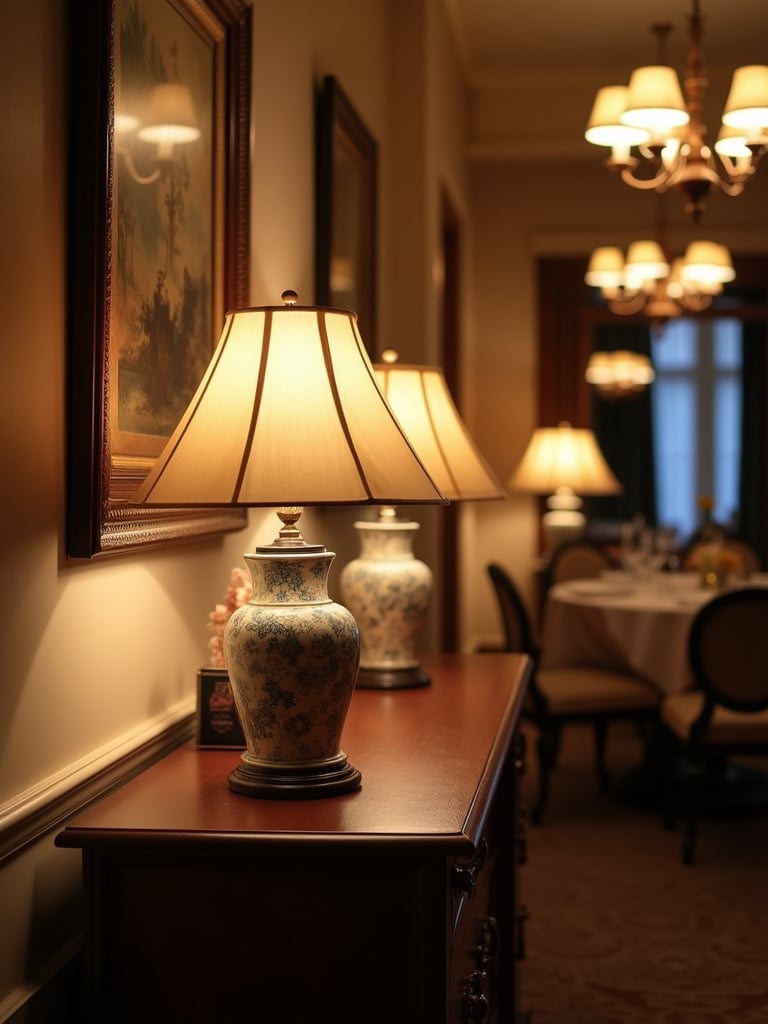
The psychological impact of table lamps extends beyond their practical illumination. Studies show that portable light sources create what environmental psychologists call “control comfort” – the reassuring knowledge that we can adjust our immediate environment as needed. This flexibility makes table lamps particularly valuable in dining rooms that serve multiple functions throughout the day.
As we consider the impact of scale in lighting design, let’s explore how oversized fixtures can transform your dining space.
Environmental psychology teaches us that scale dramatically influences our emotional response to space. Oversized pendant lights create what researchers call a “dominant spatial anchor” – a powerful visual element that helps define the dining area’s purpose and importance within a larger space. This psychological anchoring is particularly effective in open-plan environments where dining areas need clear definition.

The impact of large-scale dining room lights goes beyond mere visual drama. Studies in environmental psychology show that properly scaled oversized fixtures can create what experts call “psychological zoning” – helping to define separate functional areas without physical barriers. This makes them particularly effective in contemporary homes where dining spaces need to maintain both connection to and separation from adjacent areas.
Let’s transition from bold statements to organic textures as we explore how natural materials can enhance your dining room’s ambiance.
Research in biophilic design – the incorporation of natural elements into our built environment – shows that organic materials like rattan and wicker trigger positive psychological responses. These natural dining room lights activate what environmental psychologists call “material comfort recognition” – our innate positive association with natural textures and patterns.

The appeal of these materials goes beyond their visual texture. Studies indicate that spaces featuring natural materials promote what researchers term “stress-reduction responses,” lowering cortisol levels and promoting relaxation. The filtered light patterns created by woven materials also create subtle shadow play that our brains find particularly engaging and soothing.
As we explore different ways to create visual interest, let’s examine how the bold contrast of black fixtures can add sophisticated drama to your dining space.
Environmental psychology research has shown that high-contrast elements in design can significantly impact our spatial perception and emotional response to a room. Black dining room lights create what researchers call “visual anchor points” – strong elements that help define space while adding sophisticated drama. Studies indicate that these bold fixtures can actually make a space feel more organized and intentional, as our brains naturally use high-contrast elements to map and understand spatial relationships.

The psychological impact of black fixtures extends beyond their immediate visual appeal. Research shows that rooms featuring strategic dark elements create what experts call “depth enhancement” – making spaces appear larger and more sophisticated by providing strong visual reference points. This makes black lighting fixtures particularly effective in dining rooms where you want to create a sense of refinement and architectural interest without overwhelming the space.
As we conclude our exploration of dining room lighting, let’s examine how metallic warmth can add the perfect finishing touch to your space.
Research in color psychology and environmental design reveals that warm metallic finishes trigger what experts call “luxury association responses” in our brains. Brass and gold dining room lights tap into these deep-seated associations, creating an immediate sense of warmth and sophistication. Studies show that spaces featuring warm metallic elements tend to be perceived as more welcoming and prestigious, influencing both mood and social behavior.

The psychological impact of warm metallic lighting goes beyond simple aesthetic pleasure. Environmental psychology research indicates that materials that reflect warm light create what we call “emotional comfort zones” – spaces that feel both elegant and inviting. This dual effect makes brass and gold lighting particularly effective in dining rooms, where we want to balance sophistication with comfort and hospitality.
As we’ve explored these diverse approaches to dining room lights, we’ve uncovered a fundamental truth: lighting is far more than mere illumination – it’s a powerful tool for shaping human experience and behavior. The research is clear: thoughtfully chosen lighting can transform not just how our dining spaces look, but how we feel, interact, and create memories within them.
From the psychological impact of statement chandeliers to the subtle influence of layered lighting schemes, each choice we make can enhance our dining experiences in measurable ways. The key is understanding that different lighting solutions aren’t just design choices – they’re opportunities to create environments that support our psychological well-being and social connections.
Whether you’re drawn to the dramatic impact of oversized pendants or the intimate glow of wall sconces, remember that your dining room lighting choices can profoundly influence the experiences you create in your space. By considering both the aesthetic and psychological aspects of lighting, you can create a dining environment that not only looks beautiful but actively contributes to the well-being and enjoyment of everyone who gathers there.
The science is clear: when we illuminate our dining spaces thoughtfully, we’re not just lighting a room – we’re setting the stage for life’s most meaningful moments. Choose your dining room lights with intention, and watch as they transform not just your space, but the experiences you create within it. interior photography, medium shot of a dining room illuminated by stylish LED pendant lights above a dining table, bright and even lighting, modern and energy-efficient design, natural daylight coming through a window, slightly high camera angle showing the table setting and lighting, contemporary style, no people.